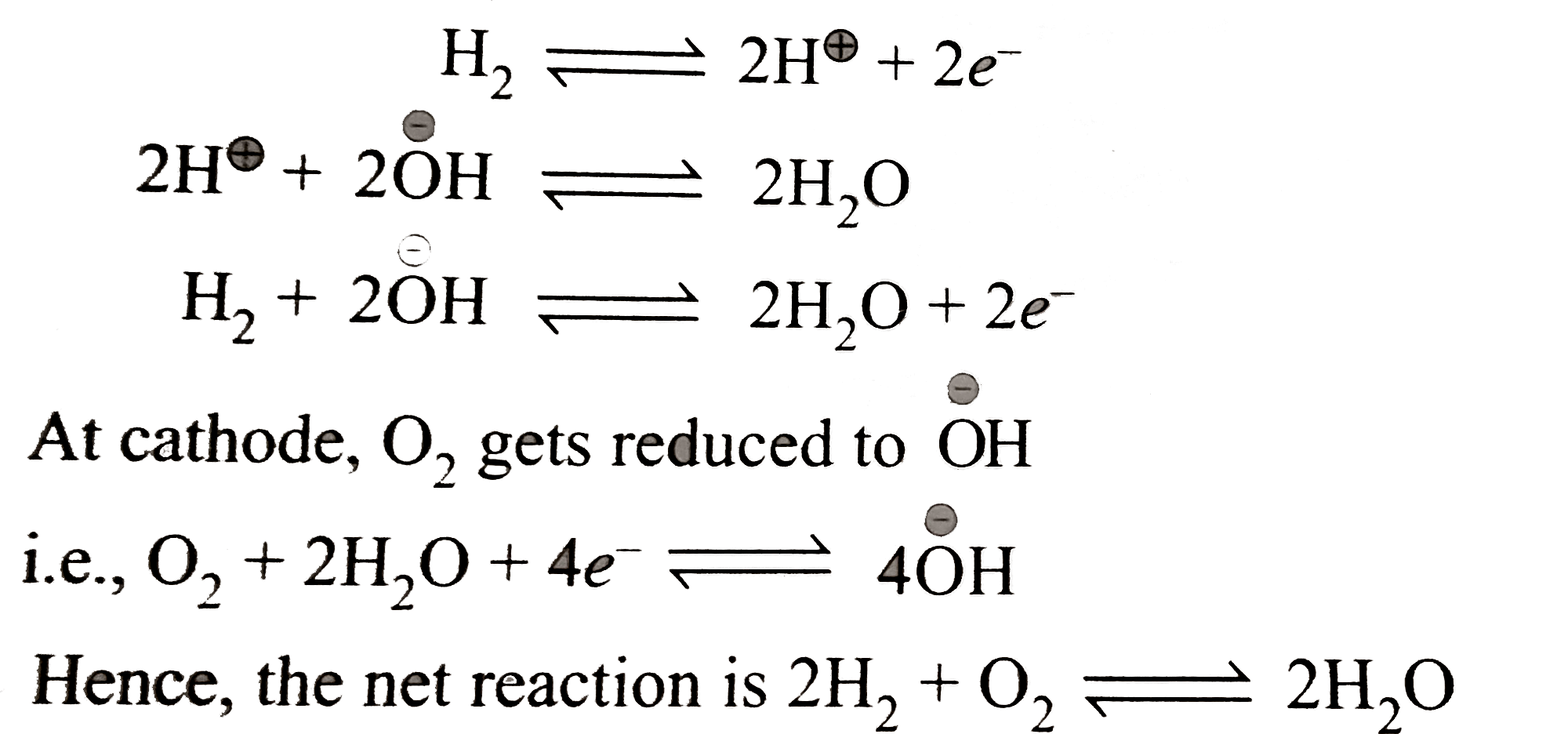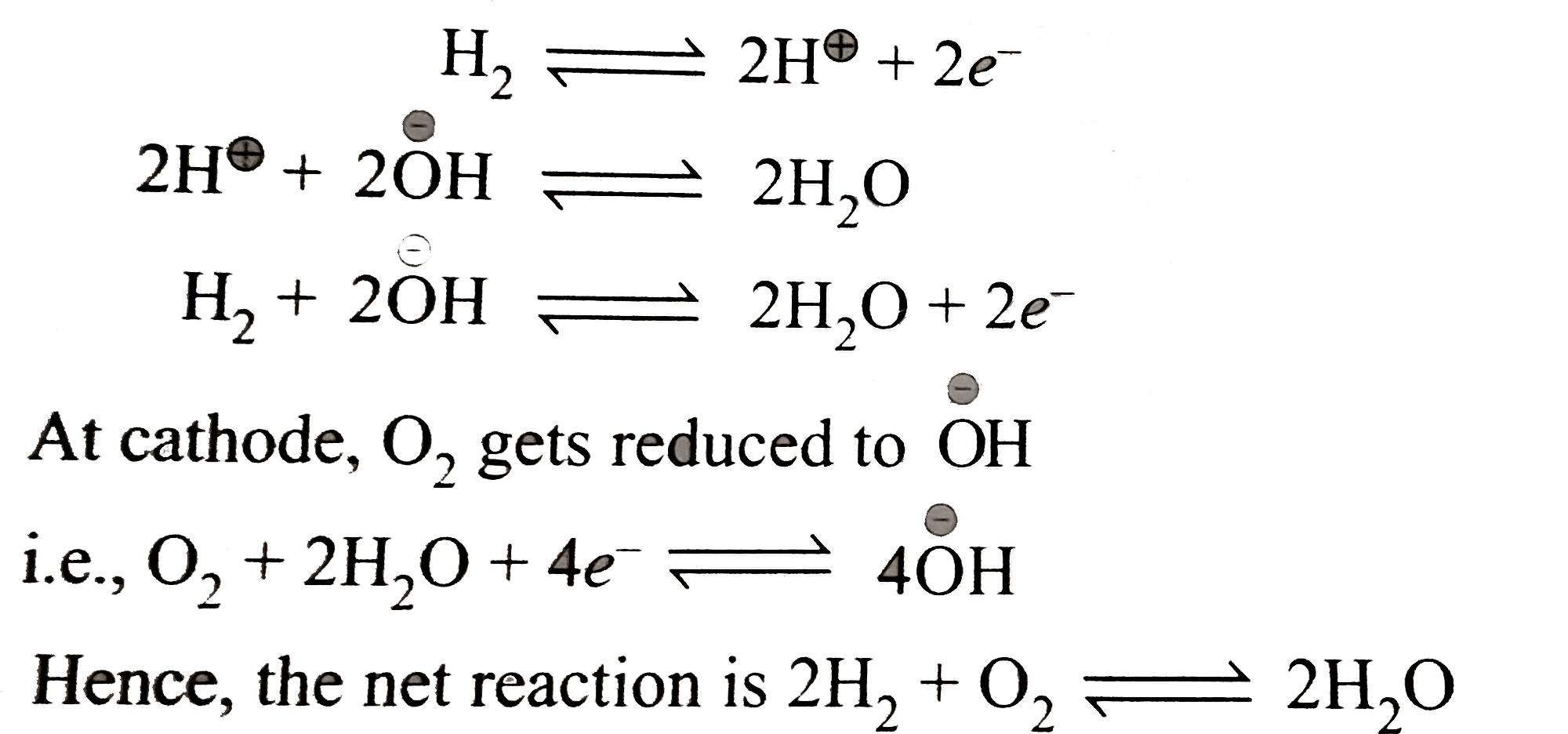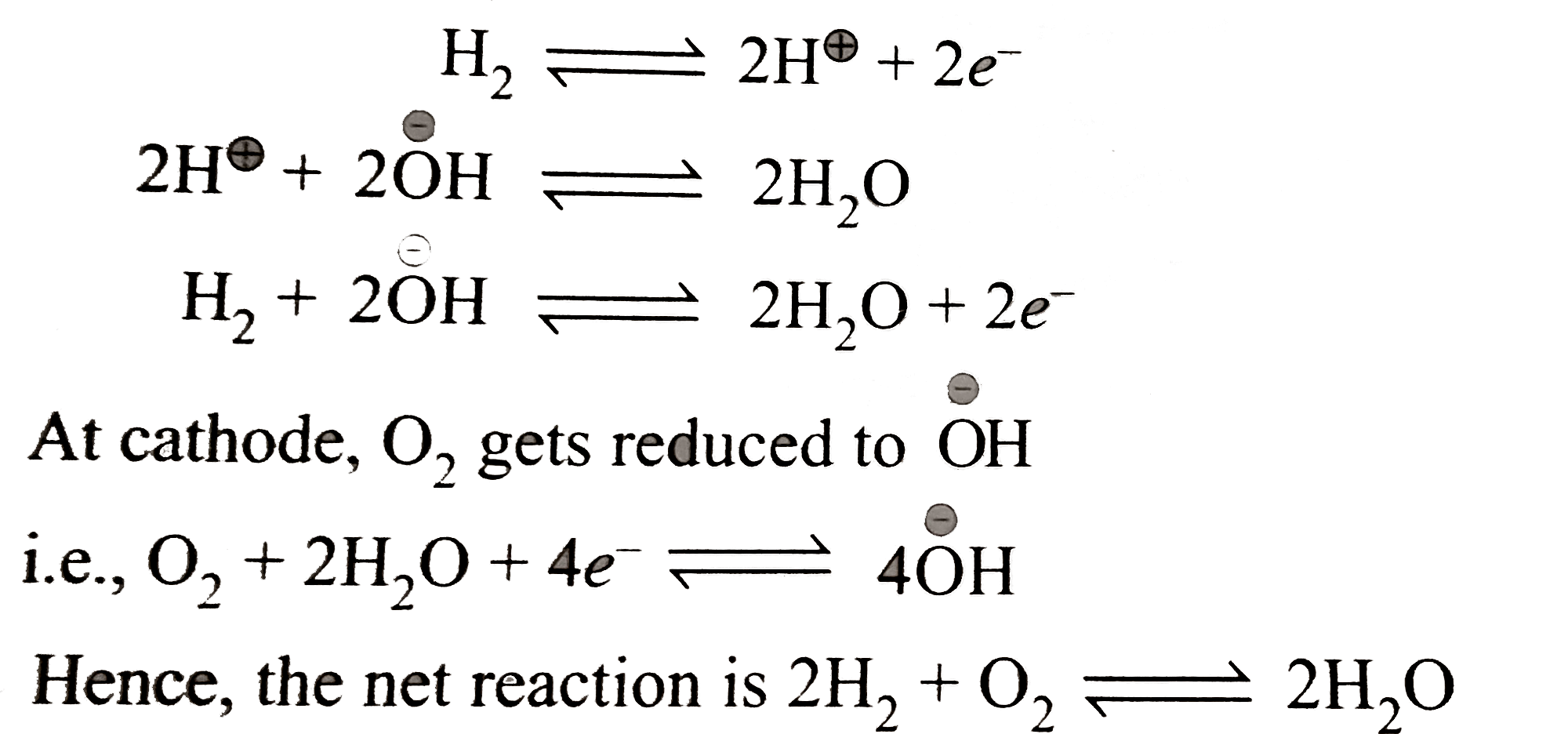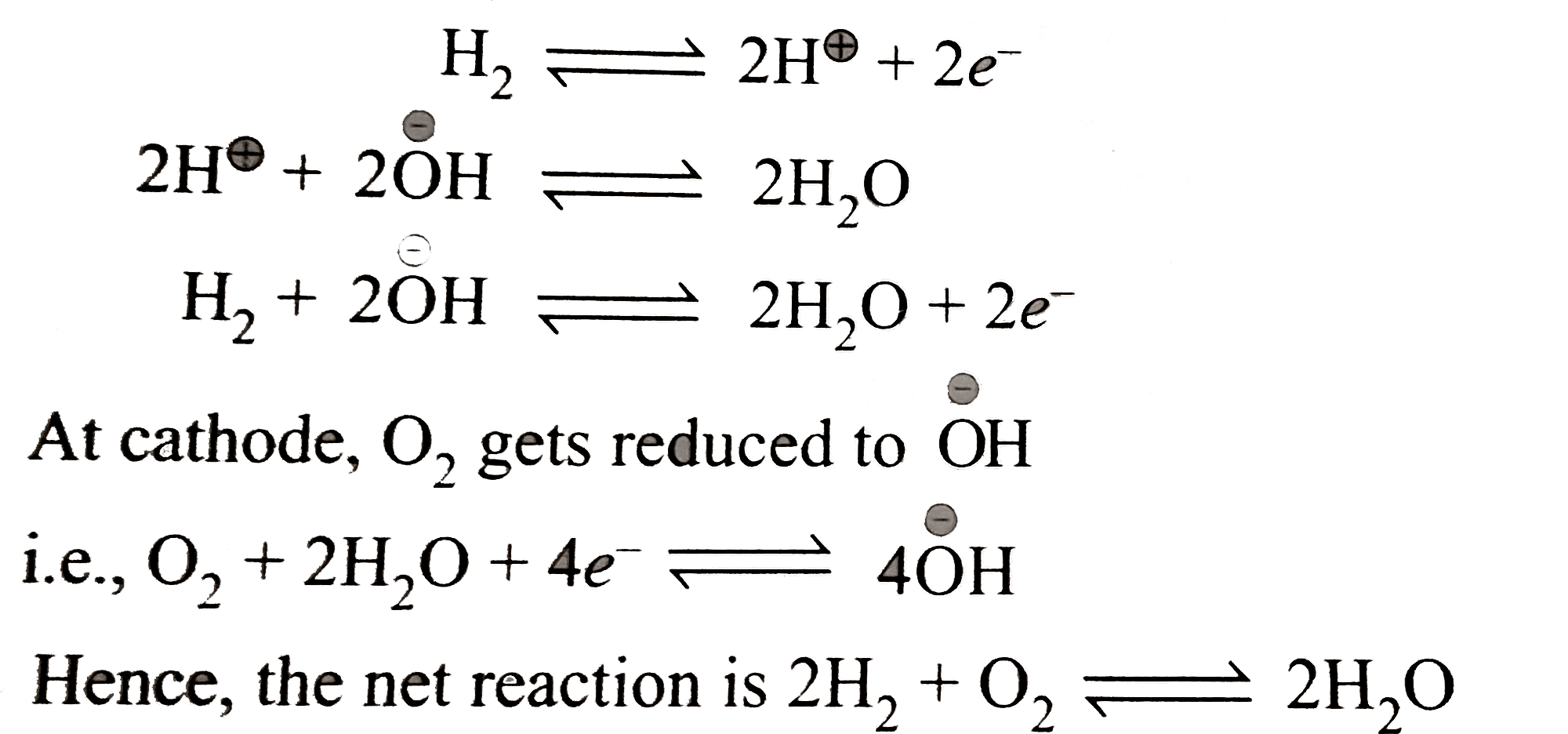The overall reactions of a hydrogen -oxygen fuel cell is
2H2(g)+O2(g)→2H2O(l)
2H2(g)+4OH(aq)→4H2O(l)+4e−
O2(g)+2H2O(l)+4e−→4OH−(aq)
4OH−(aq)+4e−→2H2O(l)
The correct Answer is:A
To find the overall reaction of a hydrogen-oxygen fuel cell, we can follow these steps:
Step 1: Identify the half-reactions
In a hydrogen-oxygen fuel cell, there are two half-reactions: one occurs at the anode and the other at the cathode.
- Anode Reaction: At the anode, hydrogen gas (H2) is oxidized.
2H2→4H++4e−
- Cathode Reaction: At the cathode, oxygen gas (O2) is reduced.
O2+4H++4e−→2H2O
Step 2: Combine the half-reactions
To find the overall reaction, we need to combine the two half-reactions. We can add them together while ensuring that the electrons cancel out.
1. Write the anode reaction:
2H2→4H++4e−
2. Write the cathode reaction:
O2+4H++4e−→2H2O
3. Combine the two reactions:
2H2+O2→4H++4e−+4H++4e−→2H2O
Step 3: Simplify the overall reaction
After canceling out the electrons and protons, we are left with the overall reaction:
2H2+O2→2H2O
Conclusion
The overall reaction of a hydrogen-oxygen fuel cell is:
2H2+O2→2H2O
In a hydrogen-oxygen fuel cell, there are two half-reactions: one occurs at the anode and the other at the cathode.
2H2→4H++4e−
O2+4H++4e−→2H2O
To find the overall reaction, we need to combine the two half-reactions. We can add them together while ensuring that the electrons cancel out.
2H2→4H++4e−
O2+4H++4e−→2H2O
2H2+O2→4H++4e−+4H++4e−→2H2O
After canceling out the electrons and protons, we are left with the overall reaction:
2H2+O2→2H2O
The overall reaction of a hydrogen-oxygen fuel cell is:
2H2+O2→2H2O
Topper's Solved these Questions
- BOOK - NCERT FINGERTPS ENGLISHCHAPTER - ELECTROCHEMISTRYEXERCISE - HOTS10videos
ELECTROCHEMISTRY
- BOOK - NCERT FINGERTPS ENGLISHCHAPTER - ELECTROCHEMISTRYEXERCISE - EXEMPLAR PROBLEMS17videos
ELECTROCHEMISTRY
- BOOK - NCERT FINGERTPS ENGLISHCHAPTER - COORDINATION COMPOUNDS EXERCISE - Assertion And Reason15videos
COORDINATION COMPOUNDS
- BOOK - NCERT FINGERTPS ENGLISHCHAPTER - GENERAL PRINCIPLES AND PROCESSES OF ISOLATION OF ELEMENTSEXERCISE - Assertion And Reason15videos
GENERAL PRINCIPLES AND PROCESSES OF ISOLATION OF ELEMENTS
Similar Questions
Purpose of hydrogen -oxygen fuel cell is to
View SolutionFuel cells : Fuel cells are galvanic cells in which the chemical energy of fuel cell is directly converted into electrical energy. A type of fuel cell is a hydrogen − oxygen fuel cell. It consists of two electrodes made up of two porous graphite impregnated with a catalyst ( platinum, silver, or metal oxide ). The electrodes are placed in aqueous solution of NaOH . Oxygen and hydrogen are continuously fed into the cell. Hydrogen gets oxidized to H⊕ which is neutralized by c−OH,i.e., anodic reaction.

At cathode, O2 gets reduced to c−OH

Hence, the net reaction is
The overall reaction has
ΔH=−285.6kJmol−1 and ΔG=−237.4kJmol−1 at 25∘C
If the cell voltage is 1.23V for the H2−O2 fuel cell and for the half cell :View SolutionFuel cells : Fuel cells are galvanic cells in which the chemical energy of fuel cell is directly converted into electrical energy. A type of fuel cell is a hydrogen − oxygen fuel cell. It consists of two electrodes made up of two porous graphite impregnated with a catalyst ( platinum, silver, or metal oxide ). The electrodes are placed in aqueous solution of NaOH . Oxygen and hydrogen are continuously fed into the cell. Hydrogen gets oxidized to H⊕ which is neutralized by c−OH,i.e., anodic reaction.

At cathode, O2 gets reduced to c−OH

Hence, the net reaction is
The overall reaction has
ΔH=−285.6kJmol−1 and ΔG=−237.4kJmol−1 at 25∘C
If the cell voltage is 1.23V for the H2−O2 fuel cell and for the half cell :View SolutionFuel cells : Fuel cells are galvanic cells in which the chemical energy of fuel cell is directly converted into electrical energy. A type of fuel cell is a hydrogen − oxygen fuel cell. It consists of two electrodes made up of two porous graphite impregnated with a catalyst ( platinum, silver, or metal oxide ). The electrodes are placed in aqueous solution of NaOH . Oxygen and hydrogen are continuously fed into the cell. Hydrogen gets oxidized to H⊕ which is neutralized by c−OH,i.e., anodic reaction.

At cathode, O2 gets reduced to c−OH
Hence, the net reaction is
The overall reaction has
ΔH=−285.6kJmol−1 and ΔG=−237.4kJmol−1 at 25∘C
What is the value of ΔSc− for the fuel cell at 25∘C?View SolutionFuel cells : Fuel cells are galvanic cells in which the chemical energy of fuel cell is directly converted into electrical energy. A type of fuel cell is a hydrogen − oxygen fuel cell. It consists of two electrodes made up of two porous graphite impregnated with a catalyst ( platinum, silver, or metal oxide ). The electrodes are placed in aqueous solution of NaOH . Oxygen and hydrogen are continuously fed into the cell. Hydrogen gets oxidized to H⊕ which is neutralized by c−OH,i.e., anodic reaction.

At cathode, O2 gets reduced to c−OH
Hence, the net reaction is
The overall reaction has
ΔH=−285.6kJmol−1 and ΔG=−237.4kJmol−1 at 25∘C
Suppose the concentration of hydroxide ioin in the cell is doubled, then the cell voltage will beView SolutionFuel cells : Fuel cells are galvanic cells in which the chemical energy of fuel cell is directly converted into electrical energy. A type of fuel cell is a hydrogen − oxygen fuel cell. It consists of two electrodes made up of two porous graphite impregnated with a catalyst ( platinum, silver, or metal oxide ). The electrodes are placed in aqueous solution of NaOH . Oxygen and hydrogen are continuously fed into the cell. Hydrogen gets oxidized to H⊕ which is neutralized by c−OH,i.e., anodic reaction.

At cathode, O2 gets reduced to c−OH
Hence, the net reaction is
The overall reaction has
ΔH=−285.6kJmol−1 and ΔG=−237.4kJmol−1 at 25∘C
What is the value of ΔSc− for the fuel cell at 25∘C?
a.−1600JK−1
b.−160JK−1
c.160JK−1
d.1600JK−1View SolutionFuel cells : Fuel cells are galvanic cells in which the chemical energy of fuel cell is directly converted into electrical energy. A type of fuel cell is a hydrogen − oxygen fuel cell. It consists of two electrodes made up of two porous graphite impregnated with a catalyst ( platinum, silver, or metal oxide ). The electrodes are placed in aqueous solution of NaOH . Oxygen and hydrogen are continuously fed into the cell. Hydrogen gets oxidized to H⊕ which is neutralized by c−OH,i.e., anodic reaction.

At cathode, O2 gets reduced to c−OH
Hence, the net reaction is
The overall reaction has
ΔH=−285.6kJmol−1 and ΔG=−237.4kJmol−1 at 25∘C
A fuel cell is
I. A voltaic cell in which continuous supply of fuels are sent at anode to perform oxidation.
II. A voltaci cell in which fuels such as :CH4,H2, and CO are used up at anode.
III. One which involves the reaction of H2−O2 fuel cell such as :
Anode :2H2O+4c−OH→4H2O(l)+4ec−
Cathode :O2+2H2O(l)=4e−→4c−OH
IV. The efficiency of H2−O20 fuel cell is 70 to 75%View SolutionDiscuss the working of hydrogen – oxygen fuel cell. What are the advantages of using this fuel cell?
View SolutionThe number of faradays required to produce one mole of water from hydrogen-oxygen fuel cell containing aqueous alkali as electrolyte is:
View SolutionElectrolysis of water is a decomposition reaction. The mole ratio of hydrogen and oxygen gases liberated during electrolysis of water is
View Solution

